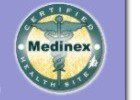|
 



 







 |
Laser Article
SOUTHWESTERN CENTER TIMES
A Publication of The University of Texas Southwestern Medical Center at Dallas
Laser clears airways in congested noses
by Shannon Swendson
People who have a chronically congested nose but who aren't helped by allergy treatment
may benefit from a new laser procedure aimed at reducing nasal tissue.
The new procedure - laser-assisted turbinate reduction (LATR) - uses a laser to reduce the
size of the turbinates, the soft-tissue projections with a bony center in the nose, which
serves as baffles to warm and humidify air.
"This is a new way of treating something that's reasonably common," said Dr.
Richard Mabry, professor of otorhinolaryngology at UT Southwestern, who performs the
outpatient procedure at the medical center's James W. Aston Ambulatory Care Center.
People may have nasal congestion because of a physical obstruction like a deviated septum
or nasal polyps. They may suffer from a condition called rhinitis, an irritation or inflammation
of the nose. Rhinitis causes the turbinates to become congested and swell so that it is
difficult to breathe through the nose.
Rhinitis may be caused by allergies, but it can also result from temperature changes,
weather changes, stress, fatigue, hormonal changes or medications. "Turbinates will
congest and swell due to a lot of things, some of which are treatable," Mabry said.
"For instance, people who have allergies should be treated appropriately for that
allergy."
Those whose rhinitis can't be treated may benefit from the LATR procedure. "There's a
significant population out there who have seen a physician and been told they're not
allergic and they just have to live with it," Mabry said. "For those people,
this may offer another way out." Mabry estimates up to 20 percent of the patients he
sees for nasal obstruction are candidates for the new procedure.
Mabry said LATR also may allow better breathing for those who have a deviated septum but
who, for other reasons, aren't candidates for the surgery to correct it. "If the
turbinates are enlarged, we can make them smaller and allow more room to breathe without
touching the septum," Mabry said.
LATR uses a carbon-dioxide laser to decrease the size of the enlarged turbinates. The
out-patient procedure requires only topical anesthetic, which is sprayed into the nose,
carries little risk of bleeding, causes little pain, requires no packing and allows
immediate return to normal activities. Before the development of the laser procedure, the
operation would have required surgery under general anesthesia, with significant risk of
bleeding.
The laser used is the same kind as the one used for the laser-assisted uvula palatoplasty
(LAUP) procedure for snoring. The LATR procedure requires special "wave guides"
designed for use inside the nose, and surgeons must be specially trained in the procedure.
Because the procedure is fairly new, Mabry said there are only a few
otorhinolaryngologists in the Unites States who are experienced in using LATR.
|

